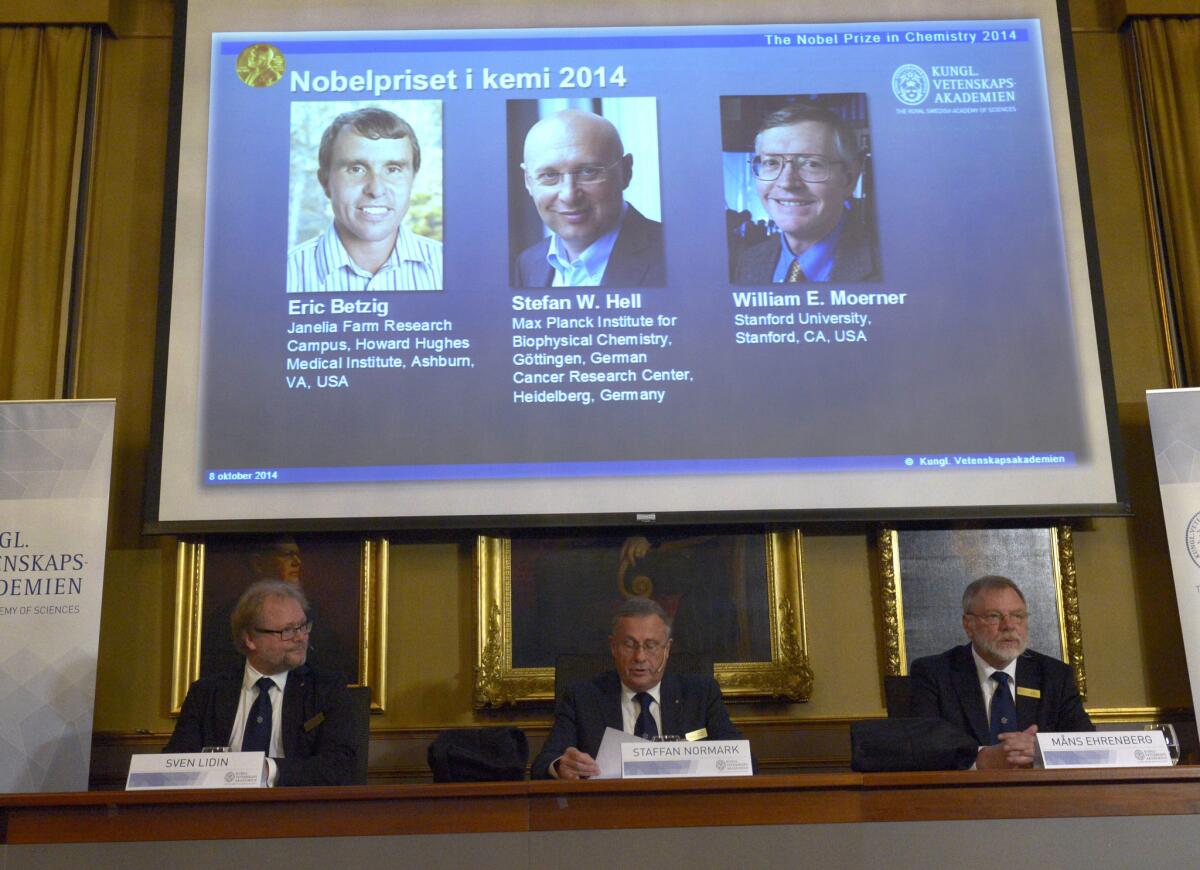Chemistry Nobel to 3 who made it possible to see the life of molecules

Science advances tool by tool, and on Wednesday it paused to recognize three practitioners who handed it the means to see the smallest secrets of a living cell.
The Nobel Prize in chemistry went to two Americans and a German who pushed beyond the physical limits of light to find another way to illuminate the choreography of molecules that make organisms work or go awry.
William Moerner, 61, of Stanford University and Eric Betzig, 54, of the Howard Hughes Medical Institute’s Janelia Research Campus in Ashburn, Va., were recognized for an imaging method that relies on turning fluorescent molecules on and off, opening a window into biological processes on a nanoscale, according to the Royal Swedish Academy of Sciences, which grants the prizes.
Stefan Hell, 51, director at the Max Planck Institute for Biophysical Chemistry in Goettingen, Germany, was credited with developing a similar imaging technique that controls this fluorescence with lasers.
“Their groundbreaking work has brought optical microscopy into the nanodimension,” the academy said.
The award was considered a swift acknowledgment of work that lies at the crossroads of chemistry, physics and biology. It also marked the second time in six years that the academy acknowledged biochemical research involving fluorescent molecules, which have helped illuminate how genes build proteins, how the human immunodeficiency virus infects cells, and how abnormal proteins accumulate in the brain, leading to diseases such as Parkinson’s, Alzheimer’s and Huntington’s.
Those advances relied in part on a protein isolated from a species of jellyfish that has floated around the deep oceans for about 160 million years. The academy awarded a Nobel six years ago to three scientists who discovered and developed green fluorescent protein, which has led to widespread use of molecular tags.
“We use these individual molecules as tiny light sources now, on structures inside cells,” Moerner said by telephone from Recife, Brazil. “They’re like little beacons, or flashlights. And we use the light from those molecules to tell us where the structure is, in precise detail.”
Homing in on such small structures has long been limited by properties of visible light. Several methods have bypassed this diffraction limit of optical microscopes, most notably by using X-rays or electrons. But specimens either had to be in a crystal form or be killed, sliced up and placed in a vacuum.
The super-resolved fluorescent microscopy pioneered by the new laureates offers alternatives that allow researchers to watch nano-scaled biological processes unfold.
“It’s really new science for a Nobel Prize,” said Tom Barton, president of the American Chemical Society.
Hell developed his laser-based method of controlling fluorescence in 2000, while Betzig used single molecule microscopy for the first time in 2006, according to the academy. Moerner’s breakthrough spanned the late 1980s to recent years.
Moerner said he learned of his award when his wife called as he was stepping out of the shower. And when he finished crediting a long list of predecessors, he paid due to science’s longtime muse, surprise.
In the late 1990s, while at UC San Diego, Moerner was surprised to see the jellyfish protein jumping around the frequency spectrum. “It’s those kinds of surprises that lead to some of the things that are truly important for what was recognized by the Nobel committee,” he said.
Moerner began his work at IBM’s research facility in Silicon Valley, with the aim of improving optical storage, and extended it at UC San Diego and Stanford.
Betzig, a physicist and engineer, took a less direct path. He left a research job at Bell Laboratories to help his father automate a machine shop in Michigan, according to the Howard Hughes institute, where he has worked since 2006. But he would frequently return to the knotty problem of the limits of microscopy, sometimes while drifting in a boat on Michigan’s Hi-Land Lake, with nothing more than “a laptop and a couple of really good ideas,” he told the institute.
Hell has worked at the Max Planck Institute since 1997. He said he had been drawn to science since he was in high school.
“The biggest risk in my career perhaps was to bet on the resolution beyond the diffraction barrier,” Hell said in an interview highlighted by Nobel officials. “In the end, it seemed to work and I was vindicated.”
The three men will share the $1.1-million award, which will be presented in Stockholm on Dec. 10.
geoffrey.mohan@latimes.com
Twitter: @LATsciguy







